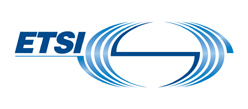Available Standards (225)
Showing standards 201 - 225

SAREF4WEAR: extension for the Wearables domain
The SAREF extension for the wearables domain (SAREF4WEAR) is based on a limited set of use cases and from available existing data models...
DISCUSSION GROUPS
Ontologies

SAREF: the Smart Applications REFerence ontology
The Smart Applications REFerence ontology (SAREF) is intended to enable interoperability between solutions from different providers and among various activity sectors in the Int..
DISCUSSION GROUPS
Ontologies

Scenario Definitions
The scope of the present document is to specify the minimum set of key scenarios for the Next Generation Protocols (NGP), Industry Specific Group (ISG)...
DISCUSSION GROUPS
IoT Internet of Things

Securing Artificial Intelligence (SAI); Mitigation Strategy Report
The goal is to have a technical survey for mitigating against threats introduced by adopting AI into systems...
DISCUSSION GROUPS
Artificial Intelligence

Securing Artificial Intelligence (SAI);Mitigation Strategy Report
The present document summarizes and analyses existing and potential mitigation against threats for AI-based systems as discussed in ETSI GR SAI 004 [i.1]...
DISCUSSION GROUPS
Artificial Intelligence

Securing Artificial Intelligence (SAI);Problem Statement
The present document describes the problem of securing AI-based systems and solutions, with a focus on machine learning, and the challenges relating to confidentiality, integrit..
DISCUSSION GROUPS
Artificial Intelligence

SmartM2M - Extension to SAREF; Part 4: Smart Cities Domain
This extension has been created by investigating resources from potential stakeholders of the ontology, such as standardization bodies (e.g...
DISCUSSION GROUPS
Smart and Sustainable Cities

SmartM2M; IoT Standards landscape and future evolutions
The scope of the present document is to provide an overview of the IoT standards landscape: requirements, architecture, protocols, tests, etc. to provide the roadmaps of the IoT..
DISCUSSION GROUPS
IoT Internet of Things

SmartM2M; SAREF extension investigation; Requirements for industry and manufacturing domains
Points to "Cyberphysical systems: the usage of robots and advanced T-capabilities (sensors, data analytics) in a production environment" as Related Standardization In..
DISCUSSION GROUPS
Robotics and autonomous systems

SmartM2M; SAREF extension investigation; Requirements for Wearables
Implications of standardization to BioMot - Smart Wearable Robots with Bioinspired Sensory-Motor Skill..
DISCUSSION GROUPS
Robotics and autonomous systems

SmartM2M; Use cases for cross-domain data usability of IoT devices
Scope of document is to identify, select and describe use cases where the IoT data and services require data usability specifications for machines consuming data for AI (for exa..
DISCUSSION GROUPS
Robotics and autonomous systems

Special Committee (SC) Emergency Telecommunications (EMTEL)
The EMTEL Special Committee is responsible for the capture of European requirements concerning emergency communication services, covering typically the four scenarios in case of..
DISCUSSION GROUPS
5G and Beyond (6G)

Speech and multimedia Transmission Quality (STQ); Framework for multi-service testing
The present document provides a framework for concurrent tests of multiple services, using a top-level approach which is also modular and scalable with respect to new services...
DISCUSSION GROUPS
Big Data & Open data

Speech and Multimedia Transmission Quality (STQ); Guidelines on OTT Video Streaming; Service Quality Evaluation Procedures
The present document's scope is to provide guidance on OTT video streaming testing approach with a set of minimum desired and most meaningful QoE centric QoS parameters alo..
DISCUSSION GROUPS
Big Data & Open data

Study of Management Capability Enablement Technologies for Consideration
The present document describes and collects the state-of-art of the existing technologies on management capability, evaluates if the technologies can match the requirements defi..
DISCUSSION GROUPS
IoT Internet of Things

Support of 5G glass-type Augmented Reality / Mixed Reality (AR/MR) devices (3GPP TR 26.998 version 17.1.0 Release 17)
The present document collects information on glass-type AR/MR devices in the context of 5G radio and network services...
DISCUSSION GROUPS
Web 4.0 and virtual worlds

Sustainable Digital Multiservice Cities (SDMC): Broadband Deployment and Energy Management: Part 1: Overview, common and generic aspects of societal and technical pillars for sustainability
The goal is to introduce the common and generic aspects of the societal and technical pillars to achieve sustainability objectives behind the deployment of smart new services wi..
DISCUSSION GROUPS
Smart and Sustainable Cities

Sustainable Digital Multiservice Communities: Broadband Deployment and Energy Management: Part 2: Multiservice Networking Infrastructure and Associated Street Furniture
The present document addresses the opportunities and challenges offered by the use of lamp-posts to provide facilities supporting services required by sustainable digital multis..
DISCUSSION GROUPS
Smart and Sustainable Cities

Technical Committee (TC) CYBER (Cybersecurity)
The rapid evolution and growth in the complexity of new systems and networks, coupled with the sophistication of changing threats, present demanding challenges for maintaining t..
DISCUSSION GROUPS
Cybersecurity/Network and Information security

Terrestrial Trunked Radio (TETRA);Testing specification; Part 1: Radio
Methods for testing whether TETRA Voice plus Data (V+D) Base Station (BS) and Mobile Station (MS) equipment and TETRA Direct Mode Operation (DMO) equipment achieve the performan..
DISCUSSION GROUPS
Artificial Intelligence

Universal Communications Identifier (UCI); Improving communications for disabled, young and elderly people
The production of a taxonomy of all disability, ageing and youth issues that could be addressed by UCI based systems and relating these to requirements for elements in the UCI a..
DISCUSSION GROUPS
Smart and Sustainable Cities

User Centric-User"
This work item will define guidance to the user in order to build his/her own service composition with the expected and relevant quality of experience (QoE) and to ensure his/he..
DISCUSSION GROUPS
Smart and Sustainable Cities

User Group; User Centric Approach; Guidance for providers and standardization makers. User Centric-Providers
This work item will define guidance to the providers and standard makers to ensure that each service component is provided with the information needed by the user to make an inf..
DISCUSSION GROUPS
Smart and Sustainable Cities

Vehicular Communications; GeoNetworking; Part 1: Requirements
The present document specifies, at an abstract level, the general, functional and performance requirements that apply to the GeoNetworking protocols (EN 302 636-4 [i.1], EN 302..
DISCUSSION GROUPS
Intelligent Transport System